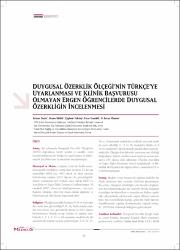Duygusal Özerklik Ölçeği’nin Türkçe’ye Uyarlanması ve Klinik Başvurusu Olmayan Ergen Öğrencilerde Duygusal Özerkliğin İncelenmesi
Künye
TATAR, Arkun, Tezan BİLDİK, Çiğdem YEKTAŞ, Fırat HAMİDİ & H. Ercan ÖZMEN. "Duygusal Özerklik Ölçeği’nin Türkçe’ye Uyarlanması ve Klinik Başvurusu Olmayan Ergen Öğrencilerde Duygusal Özerkliğin İncelenmesi". Nobel Medicus, 12.1 (2016): 39-48.Özet
Bu çalışmada Duygusal Özerklik Ölçeği'nin (DÖÖ) doğrulayıcı faktör analizi ve madde cevap kuramı kullanımı ile Türkçe’ye uyarlanması ve psikometrik özelliklerinin incelenmesi amaçlanmıştır.
Materyal ve Metot: Çalışma, İzmir’de farklı sosyodemografik özelliklere sahip dört lisedeki 14-20 yaş arasındaki 600’ü kız, 445’i erkek ve altısı cinsiyet belirtmemiş toplam 1,051 öğrenci ile gerçekleştirilmiştir. Çalışmada veri toplam aracı olarak DÖÖ ve Ana-Baba ve Ergen İlişki Envanteri kullanılmıştır. 20 maddeli DÖÖ, ebeveyni idealleştirmeme, ebeveyne bağımlı olmama, ebeveyni insan olarak algılama ve bireyleşme alt ölçeklerini kapsamaktadır.
Bulgular: Ölçeğin içtutarlık katsayısı 0,78 ve Guttman iki yarım test güvenirliği 0,79, üç hafta arayla yapılan test-tekrar test güvenirlik katsayısı 0,65 olarak bulunmuştur. Madde cevap kuramı ile yapılan analizlerde 1, 2, 4, 9, 11 ve 18 numaralı maddelerde iki parametreli modele uyumu gözlenmiştir. 3, 8, 10, 14, 16 ve 19 numaralı maddeler en düşük seviyede madde ayırt ediciliği, 7, 17 ve 18. maddeler düşük, 6, 8 ve 10. maddeler yüksek madde güçlük düzeyi göstermişlerdir. Ölçeğin dört faktörlü yapısının test edildiği Doğrulayıcı Faktör Analizi sonucunda iyi uyum katsayısı 0,81 olarak elde edilmiştir. Ölçeğin Ana-Baba ve Ergen İlişki Envanteri Genel Anlaşmazlık ve Bütünlük alt ölçekleri ile bağıntı düzeyi sırasıyla 0,55 ve 0,48 bulunmuştur. Sonuç: Madde cevap kuramı ile yapılan analizler bu ölçek yapısının bazı sorunlu yönlerini göstermiştir. Bu sonuç, duygusal özerkliğin çok boyutlu doğasından kaynaklanmaktadır. Bu nedenle ileride duygusal özerkliğin belirleyicileri ve sonuçlarına ilişkin yapılacak çalışmalarda çok boyutlu yapısı dikkate alınmalıdır. Bazı sınırlılıklara karşın, geniş bir Türk öğrenci örnekleminde yapılan derinlemesine yapısal analizler, DÖÖ’nün kullanışlı olduğunu göstermiştir. The study is aimed to adapt the Emotional Autonomy Scale (EAS; Steinberg & Silverberg, 1986) to Turkish through the use of confirmatory factor analysis and item response theory, and to examine the psychometric characteristics of the scale.
Material and Method: The study was done among 1,051 students (600 girls, 445 boys, 6 not identified sexuality; aged 14-20) in four high schools from different socioeconomic levels in İzmir. In the study, the Turkish form of the EAS and the Parent-Adolescent Relationship Questionnaire (PARQ) were used as data collection tools. Emotional Autonomy was measured by 20-item EAS, which included deidealization, nondependency on parents, perceives parents as people, and individuation subscales. Results: The internal consistency coefficient was 0.78 and the Guttman split-half coefficient was 0.79. The test-retest reliability by three weeks was 0.65. The analysis of items by item-response theory indicated that the six items (item 1, 2, 4, 9, 11, and 18) represented a good fit to the two-parameter model fit. The analysis of items by item response theory indicated that item 3, 8, 10, 14, 16 and 19 to be the least discriminant item, and consecutively item 7, 17 and 18 followed. The most discriminant items happened to be 6, 8, and 10. The four factor structure of the scale was tested and the Goodness of Fit Index was 0.81 through confirmatory factor analysis. The correlation coefficients between the EAS total score, and the PARQ Global Distress and Cohesion Subscales were 0.55 and -0.48 respectively.
Conclusion: The analysis of items by item-response theory showed some problematic aspects of the construction of this scale. This result is due to the fact the emotional autonomy is very likely to be multidimensional in nature. Therefore, in future studies of predictors and outcomes of the emotional autonomy, multidimensionality should be taken into account. Despite some limitations, an in-depth structural analysis of the EAS in a large sample of Turkish students indicates that it is possible to give a useful interpretation to the EAS.



















